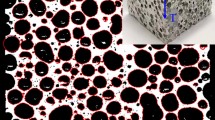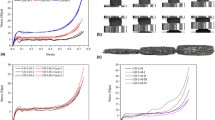Abstract
Aluminum foams were prepared by melt foaming process. The mechanical properties of aluminum foams under repeated impacts were studied. The porosity and pore size of the prepared aluminum foam were measured. The effects of damage accumulation on the failure morphology of aluminum foam, the transmission rate, stress–strain curve, energy absorption capacity, and the ideal energy absorption efficiency were analyzed. The influence of the number of impacts on the dynamic mechanical properties of the material under the condition of equivalent damage accumulation was studied. Based on the Sherwood–Frost equation, the damage cumulative constitutive model of the aluminum foams under repeated impacts was established. The influence of the difference between the damage cumulative energy corresponding to the reference curve of the shape function and the damage cumulative energy in multiple impacts tests on the prediction accuracy of the constitutive model was analyzed. The results show that with the increase in the number of impacts, the degree of damage to aluminum foam increases, transmission rate increases, the elastic limit stress and the corresponding strain are enhanced, and the damage accumulation effect on aluminum foam under repeated impacts is helpful to improve the ideal energy absorption efficiency. It is verified that the constitutive model can reflect the mechanical properties of aluminum foam under repeated impacts.















Similar content being viewed by others
Abbreviations
- \( \bar{D} \) :
-
Average pore size
- \( X_{D} \) :
-
Pore size probability
- \( K \) :
-
Uniformity
- A :
-
Cross-sectional area of the bar
- C :
-
Wave velocity
- E :
-
Elastic modulus
- \( L_{\text{s}} \) :
-
Thickness of samples
- \( A_{\text{s}} \) :
-
Cross-sectional area of samples
- \( \varepsilon_{i} \left( t \right) \) :
-
Strain on the incident bar
- \( \varepsilon_{t} \left( t \right) \) :
-
Strain on the transmitted bar
- \( W_{i} \) :
-
Energy of incident wave from the beginning to the unloading
- \( \sigma_{i} \) :
-
Incident wave stress
- \( T \) :
-
The time from loading to unloading
- \( \dot{\varepsilon } \) :
-
Strain rate
- \( \sigma_{\hbox{max} } \) :
-
Maximum stress on the stress–strain curve in the strain range of 0–\( \varepsilon \)
- η :
-
Ideal energy absorption efficiency
- \( T_{\text{m}} \) :
-
Temperature of the test environment
- \( \rho \) :
-
Density of the material
- \( H\left( {T_{\text{m}} } \right) \) :
-
Temperature influence function
- \( G\left( \rho \right) \) :
-
Density function
- \( M\left( {\varepsilon ,\dot{\varepsilon }} \right) \) :
-
The strain rate enhancement
- \( f\left( \varepsilon \right) \) :
-
Shape function
- \( N\left( {W,\dot{\varepsilon }} \right) \) :
-
Elastic ultimate stress under different initial impact conditions
- \( W_{m}^{n} \) :
-
The sum of the initial impact to the nth impact incident energy under the condition that the initial impact velocity is m
- \( a_{m} \), \( b_{m} \), \( c_{m} \) :
-
The corresponding fitting parameters
- \( \sigma_{0} \) :
-
The elastic ultimate stress corresponding to the reference curve
- \( q \) :
-
The number of terms expanded by the power series
- \( E_{p} \) :
-
The fitting parameter to the reference curve
- \( E_{j} \) :
-
The absolute value of the difference between the damage cumulative energy corresponding to the reference curve of the shape function and the damage cumulative energy in the jth impact
- \( S_{j}^{2} \) :
-
The discrepancy between the predicted curve and the experimental measured curve
References
F. Binesh, J. Zamani, M. Ghiasvand, Ordered structure composite metal foams produced by casting. Int. J. Metalcast. 12, 89–96 (2018)
M. Goel, V. Matsagar, A. Gupta, Blast resistance of stiffened sandwich panels with aluminum cenosphere syntactic foam. Int. J. Impact Eng 77, 134–146 (2015)
M. Alizadeh, M. Mirzaei-Aliabadi, Compressive properties and energy absorption behavior of Al–Al2O3 composite foam synthesized by space-holder technique. Mater. Des. B35, 419–424 (2012)
I. Orbulov, Compressive properties of aluminum matrix syntactic foams. Mater. Sci. Eng., A 555, 52–56 (2012)
Y. Wang, C. Wang, Effect of structure characteristic parameters and strain rate on the compressive mechanical properties of aluminum foams. Acta Armamentarii 32, 106–111 (2011)
W. Xie, H. Du, S. Li, Experimental study on dynamic mechanical performance of polyurethane-aluminum foams composites. Acta Mater. Compos. Sin. 28, 103–108 (2011)
Y. Alvandi-Tabrizi, D. Whisler, H. Kim, A. Rabiei, High strain rate behavior of composite metal foams. Mater. Sci. Eng., A 631, 248–257 (2015)
P. Wang, S. XU, S. HU, Compressive behavior and deformation mechanism of aluminum foam under different temperature. J. Vib. Shock 32, 16–19 (2013)
C. Cady, G. GrayIII, C. Liu, Compressive properties of a closed-cell aluminum foam as a function of strain rate and temperature. Mater. Sci. Eng., A 525, 1–6 (2009)
M.S. Aly, Behavior of closed cell aluminum foams upon compressive testing at elevated temperatures: experimental results. Mater. Lett. 61, 3138–3141 (2007)
Y. Zhang, G. Sun, X. Xu, Identification of material parameters for aluminum foam at high strain rate. Comput. Mater. Sci. 74, 65–74 (2013)
Y. Ding, L. Yang, L. Wang, Experimental determination of dynamic constitutive parameters for aluminum foams. Explos. Shock Waves 35, 1–8 (2015)
J. Harrigan, S. Reid, P. Tan, High rate crushing of wood along the grain. Int. J. Mech. Sci. 47, 521–544 (2005)
M. Kyle, K. Balint, C. Pedro, Quasi-static and high strain rate response of aluminum matrix syntactic foams under compression. Compos. A 79, 82–91 (2015)
P. Wang, S. Xu, Z. Li, Temperature effects on the mechanical behavior of aluminum foam under dynamic loading. Mater. Sci. Eng., A 599, 174–179 (2014)
Y. Zhang, L. Chen, R. Chen, Dynamic mechanical property experiment and constitutive model establishment of polyurethane foam aluminum. Explos. Shock Waves 34, 373–378 (2014)
L.B. Matijasevic, J. Banhart, S. Fiechter, O. Gorke, Modification of titanium hydride for improved aluminum foam manufacture. Acta Mater. 54, 1887–1900 (2006)
L. Bertholf, C. Karnes, Two-dimensional analysis of the SHPB system. J. Mech. Phys. Solids 23, 1–19 (1975)
Z. Wang, X. Cao, H. Ma, Experimental studies on the dynamic compressive properties of open-celled aluminum alloy foams. Explos. Shock Waves 26, 46–52 (2006)
R. Hartley, T. Cloete, G. Nurick, An experimental assessment of friction effects in the spilt Hopkinson pressure bar using the ring compression test. Int. J. Impact Eng 34, 1705–1728 (2007)
B. Zhang, Y. Lin, S. Li, Quasi-static and high strain rates compressive behavior of aluminum matrix syntactic foams. Compos. B 98, 288–296 (2016)
H. Yu, Z. Guo, B. Li, G. Yao, H. Luo, Y. Liu, Research into the effect of cell diameter of aluminum foam on its compressive and energy absorption properties. Mater. Sci. Eng., A 32, 454–455 (2007)
J. Sherwood, C. Frost, Constitutive modeling and simulation of energy absorbing polyurethane foam under impact loading. Polym. Eng. Sci. 32, 1138–1146 (1992)
Y. Hu, C. Wang, S. Hu, An empirical dynamic constitutive model for aluminum foams and its implementation in LS-DYNA. Acta Armamentarh 35, 46–50 (2014)
Z. Wang, L. Jing, L. Zhao, Elasto-plastic constitutive model of aluminum alloy foam subjected to impact loading. Trans. Nonferr. Metals Soc. China 21, 449–454 (2011)
Acknowledgements
The authors wish to acknowledge, with thanks, the financial support from the Army Key Research Projects. We would like to thank Ms. Gao for proofreading the paper.
Author information
Authors and Affiliations
Corresponding author
Electronic supplementary material
Below is the link to the electronic supplementary material.
Rights and permissions
About this article
Cite this article
Gao, H., Xiong, C., Yin, J. et al. Research on Dynamic Accumulation Effect and Constitutive Model of Aluminum Foams Under Dynamic Impact. Inter Metalcast 13, 146–157 (2019). https://doi.org/10.1007/s40962-018-0245-0
Published:
Issue Date:
DOI: https://doi.org/10.1007/s40962-018-0245-0




